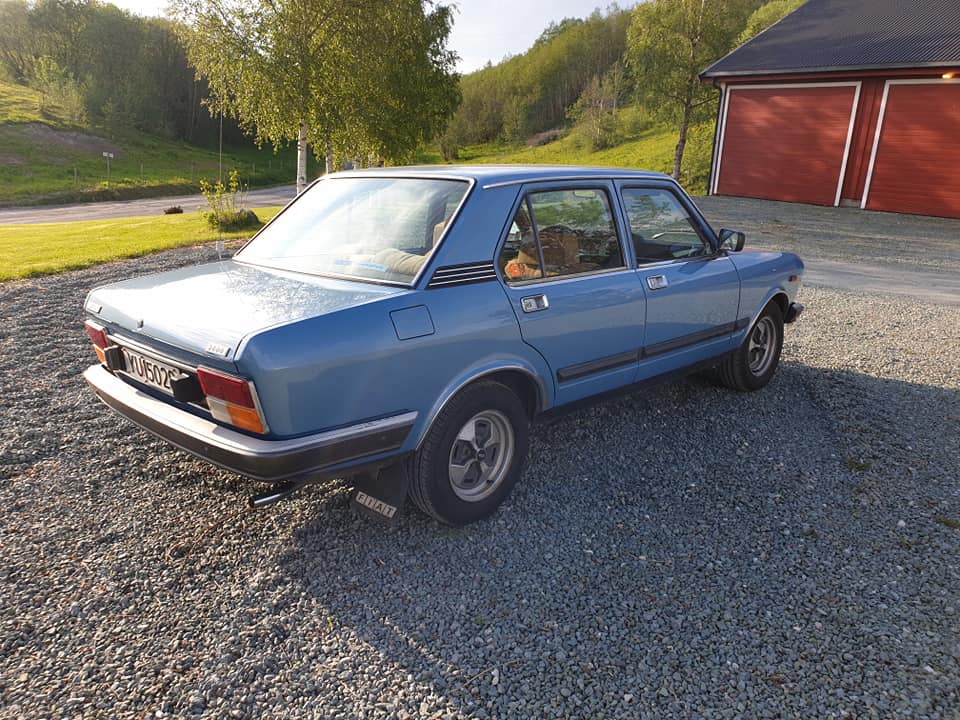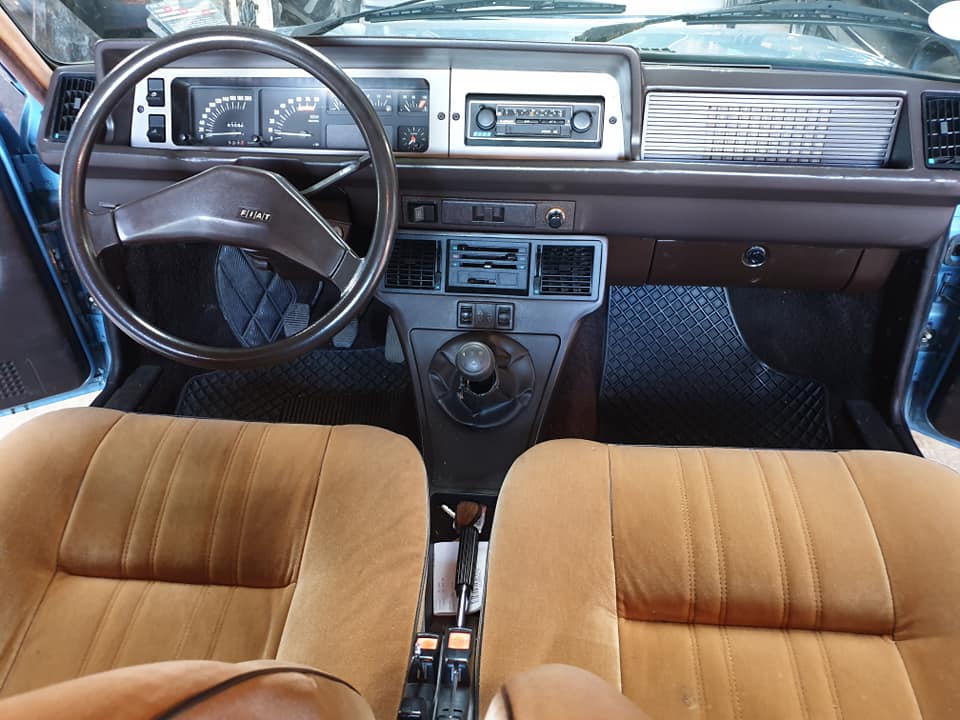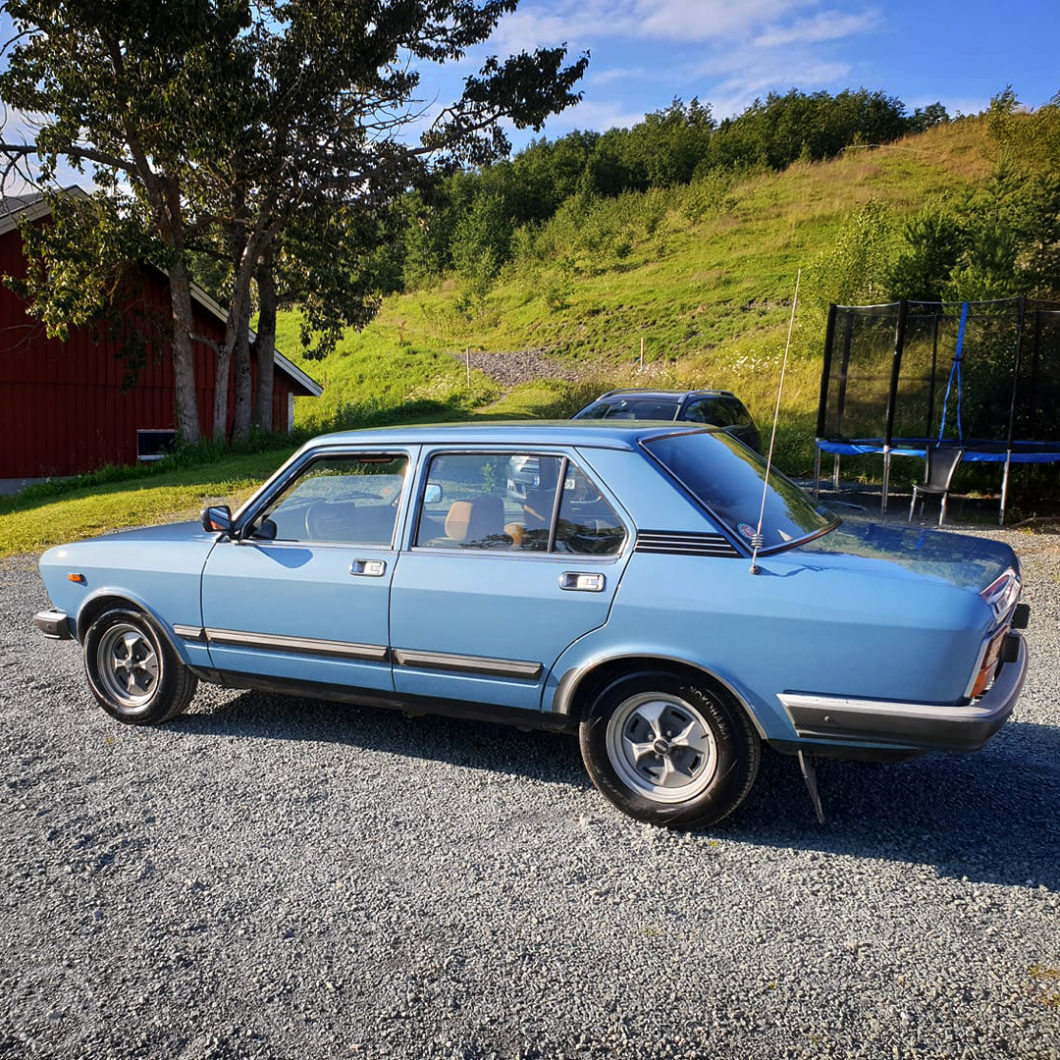It wasn’t originally meant to be a “flagship.” When the Fiat 132 was new, it was just the latest iteration of Fiat’s large family car – descended from the old Fiat 1400/1500 and its immediate predecessor, the 125. At that time, in 1972, Fiat’s top car was the V6 130, offered as a BMW-baiting Berlina or Paolo Martin’s gorgeous Pininfarina Coupe.
If the 130 was aimed at cars like the BMW’s big E3 sedan and E9 coupe, the 132 targeted large family cars like the Peugeot 504 and Opel Rekord. It was a large family car, and though the 125 had been relatively enthusiast-friendly for that type of vehicle, it wasn’t ever going to be the most famous of Fiats.
Circumstances, of course, changed the mission of the 132 over time, and the car itself seemed to be perennially changing. In total, the car was subject to four major updates over its long career, some mechanical, some visual. 132s were built from early 1972 to late 1985, with the final few years renamed “Argenta” as Fiat ditched numbers for names.
Largely outshone by the smaller Fiat 131 Mirafiori, with its rallying connections, and the larger, departed luxury 130, the 132 was actually quite a success for Fiat, but it’s almost unknown today outside of Italy, with relatively few survivors. It deserves more recognition than it gets.
We often look at cars from a U.S. perspective, but the 132 was never sold in North America. It would have been a good choice for the U.S. market and fairly easy to federalize, but Fiat never seemed interested in making that happen. This 1979 132, a rare survivor, comes courtesy of Jørgen Romsås Olsen of Norway.
Fiat’s Big Cars
During the long tenure of Dante Giacosa, officially Fiat’s engineering boss from 1937 to 1970 (though his titles changed in 1950), the attention was always on small cars starting with the original 500, then the Nuova 500, the 600, and ultimately the 127 and 128 which came towards the end of his tenure.
Small cars were synonymous with Fiat by then, but the company dominated Italy like few other manufacturers have ever dominated any market, commanding an 80-90% market share. Consequently, it made cars for every purse and purpose for a long time. In the 1960s, buyers wanting a big car from Fiat bought an 1800 or a 2300, big (for Europe) rear drivers with nice fittings, the range being topped by the Ghia-bodied 2300S coupes.

There was a big gulf between these cars and Fiat’s midsizer, the 1300/1500, and 1961 saw the 1800 body combined with the 1500 engine to create the 1500L. The 1500L sold well as a taxi, but was always a compromise between price and power. The 1300, the big seller in that range, was destined to be replaced by the Fiat 124.
To create a successor to the 1500 and the 1500L, the answer was a bigger and more powerful version of the 1500 that leveraged some of the new 124’s technology, and car became the Fiat 125.
The 125 looked just like a 124, but larger. But while externally similar to the newer, smaller 124, the 125’s chassis was mostly retained from the circa-1961 midsize 1500.
The 125 used only the Aurelio Lampredi-designed 90-hp 1,608-cc twin-cam four from the 124 Sport. A year after it went on sale, it also got an optional 5-speeder for 1968 and a 100-hp 125 “S” variant. This made the 125 a vastly nicer car to drive than the wheezy 1500L or the old midsize 1500. The older chassis did not offer the same sharp handling as the 124, but the smooth and revvy engine made up for most shortcomings.
The 125 would soon be licensed to FSO in Poland, where it became the Polski-Fiat 125P. This version is perhaps better remembered today than the original 125 because it was on sale much longer, ultimately spawning the FSO Polonez, another large-ish car created on the 125’s bones. The original Italian 125 was considered a praiseworthy car for a big family machine at the time – and more than 600,000 of them found homes in five and a half years despite offering only a single powerplant and body style.
The 125 also effectively replaced the slow-selling Fiat 1800, leaving the 2300 to grow into a de facto luxury car – 1969’s 130, powered by another Lampredi engine, this time a sonorous 140-hp V6 in a thoroughly modern chassis.
The backdrop for the creation of these cars was Italy’s huge economic expansion, which lasted from the mid-1950s until the early 1970s. In 1955, only 3% of Italian homes had refrigerators, but virtually all Italians had them by the early 1970s.
The rising tide of consumerism meant an increased appetite for vehicles generally and, among those who already had cars, ever larger ones. The Fiat 1100 was a middle class car in the early 50s, but its descendant, the 1,116-cc Fiat 128, was a working class machine in 1970. But in the late 1960s Italy’s economy began to cool, rocked by strikes, political clashes (sometimes involving assassinations, bombings, and arson), and dissatisfaction with Italy’s ruling Christian Democracy party.
The postwar boom had also seen a huge dislocation of populations as many workers left their homes in the agricultural South for work in the Industrial North, where they were far from home and dependent on their employers. 1969’s “Hot Autumn” labor movement brought strikes for better worker protections and pay into Fiat’s own Mirafiori plant.
Fiat 132, Take One
When it came time to replace it, Fiat intended to expand the 125’s limited range by offering a car that had more engine choices and which looked more like the luxury 130 Berlina.
The styling of the proposed replacement was done at Fiat Centro Stile under Gianpaolo Boano, and it reflected the themes of Boano’s 130 Berlina. The body structure and some of the interior components were designed with a new eye to safety, including integrated crumple zone and a collapsible steering column, very current in 1972. The car was longer and had more room inside. It was a proper five seater. Instead of just one engine, it would have two – now the 1,592-cc and 1,756-cc twin cam fours.
The car was ready to go on sale by April of 1972.
Underneath, not all that much was changed from the 125. Fiat erred on the side of conservatism on the 132 in inverse proportion to how radical it went with the smaller 127 and 128, and that hurt the car at launch. The suspension seemed to have been reworked for a smoother ride, but it seemed to give up some of the responsiveness of the 125 in favor of understeery softness. The steering was singled out as being far too heavy and numb.
Criticism of these early 132s and their plain looks did not help the car get off to a strong start. Fiat initiated a crash program to modify the new car almost right away, although the earliest a revised car could appear would be late 1973.
The car was modified inside and out – with tighter and revised suspension settings and bushings and a modest restyle that may or may not have been the work of Marcello Gandini at Bertone. Bertone was a frequent collaborator with Centro Stile and there was plenty of cross pollination between Fiat and the style house.

The most noteworthy exterior revisions were a new front fascia and a subtly updated body side and C-pillar, now with a vaguely BMW look. Not coincidentally, Gandini’s work also went into the BMW E12 5 Series, a car of similar size and not so different visuals but which cost more. The Fiat now looked and felt a little more modern, even if the updates were fairly modest.
Unfortunately, the timing coincided with the OPEC crisis, which hit Italy – then experiencing one political crisis after another – very hard. Larger cars were suddenly impossible to sell in the country and both the big 130 and the 132 were left languishing the same way unwanted Chrysler New Yorkers were in America. The revised 132 was also up against the brand-new Fiat 131, which could be configured to be very similar in spec but lower in price, which didn’t help.
The 132 Evolves
After OPEC, the slow-selling 130, which only moved about 15,000 units in seven years (plus around 4,000 coupes), was on life support. In 1976, Fiat finally dropped the big luxury car, which had the handicap of being sold under the “low end” Fiat brand outside of its Italian niche.
With the 130 gone and market circumstances now quite changed, the 132 inherited the flagship role – being Fiat’s largest and most senior product. Now with a new mission, the car was given a major style update for 1977 and a new top spec. Joining the 1600 and 1800 was a 2-liter (technically 1,995-cc) twin cam. All used a standard five-speed with different axle ratios optional on the 2000 for long cruising or urban acceleration.
Inside, Fiat revised the interior to make it a little richer – standard seating was now velour instead of vinyl or regular cloth. The company also began adding what were then luxury features like vanity mirrors in an attempt to cover both family car and executive car buyers. The 132 was hardly an American-style “Brougham,” but Turin had appropriately upgraded it to cover both family buyers and the executive car class – where it competed with the likes of the Citroën CX and higher-spec Opel Rekord.
Some upgrades to materials came with cost reductions elsewhere – rear disc brakes gave way to drums in 1977. That helped keep the overall cost down – for what was a range-topper, a well-equipped 132 was lower in price than the higher-end CXs, Rekords, and Cortinas. Italy’s weak currency, perhaps the only good thing to come out of the economic problems there, made them cheap to export.
The styling revisions were in the mode of the 131 and the E12 5-series, but the 132’s new plastic bumpers made it more modern looking than the earlier chrome sixties-style units.

The range got even wider in 1978 with the addition of the first Diesel engines, which would eventually be a mainstay of larger European cars. The original 2-liter Sofim diesel made only 60hp, but also returned 35+ MPG, well suited for OPEC II. A 2.5-liter, 72-hp diesel soon followed. In 1979, Fiat added fuel injection to the 2000, with 125-hp on tap.
Often advertised as “a sports car on the weekend,” the 132 had all of the basic ingredients of the biggest and best 131s, but with more room. It wasn’t quite as sharp a handler, but in 2000 form it was a good balance of a fun car to drive but a relaxing car to live with.
Argenta
132 sales picked up from 1976-79, but were always strongest in Italy and France. The car was also manufactured in Spain by Seat (then a Fiat affiliate) and in Poland and Yugoslavia – though in those later two cases, it was mostly for officialdom and rarely seen in the numbers of other licensed Fiats like the 125P or the Zastava Skala. The 132 was also built in South Korea by Kia in CKD form for a time, and in South Africa at Rosslyn.
While these international models were going strong, the 132 was now an eight year old car on even older chassis in its primary markets. In 1981, Fiat gave it yet another restyle and a new name – Argenta. Now with an “aero look” front and rear, the Argenta had entirely new body panels except for the doors, but was arguably less distinctive than the outgoing 132.
The levels of standard equipment were both expanded on the Argenta, which was now marketed almost purely as an executive car. They included a much ballyhooed on-board diagnostic system and more power features on top of a refreshed interior, updated in a way similar to the exterior. A turbodiesel 2.5 eventually joined a slightly pared back line of engines.
The Argenta was viewed with cynicism by the press who correctly saw it as an upgraded 132, but Fiat was largely doing what it could to invest in a large car segment that was no longer all that popular at home – Fiat sold dozens of 127s for every Argenta. If you were going to sell a large car, Fiat figured, it had to be at a low cost and high margin with lots of features.
The last gasp of the Argenta was the Volumex – an export-only derivative that used a supercharged 2-liter twin cam shared with Lancia. By the time it appeared in 1984, the Argenta’s replacement was almost ready. That car was the original Fiat Croma, co-developed with Saab and Alfa-Romeo as part of the “Type 4” project.
132s were in their prime from roughly 1976-1980 and sales were fairly good. More than 600,000 were made overall – a small number compared to the 125 given how long it was on sale, but respectable considering the circumstances. Like all 1970s Fiats, the enemy was rust – and many were felled early by a lack of corrosion protection.
All Photos ©Jørgen Romsås Olsen 2020.


Great article but a couple of points to add – in the end total production of 132 and Argenta was nearly 1m. The Volumex was available in Italy as the SX while the export version was called VX.